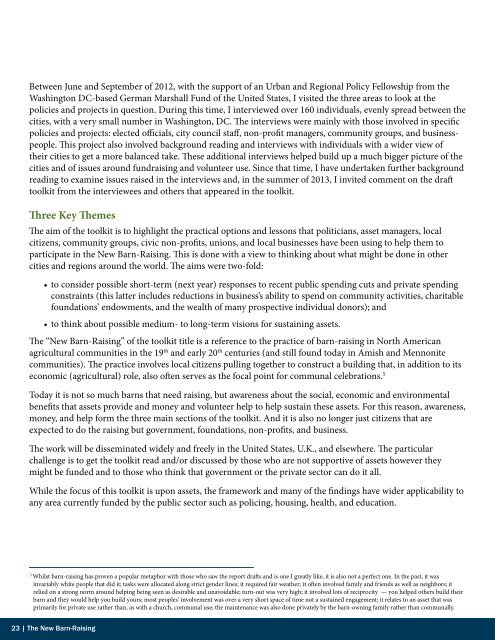bQNs7mR
bQNs7mR
bQNs7mR
Create successful ePaper yourself
Turn your PDF publications into a flip-book with our unique Google optimized e-Paper software.
Between June and September of 2012, with the support of an Urban and Regional Policy Fellowship from the<br />
Washington DC-based German Marshall Fund of the United States, I visited the three areas to look at the<br />
policies and projects in question. During this time, I interviewed over 160 individuals, evenly spread between the<br />
cities, with a very small number in Washington, DC. The interviews were mainly with those involved in specific<br />
policies and projects: elected officials, city council staff, non-profit managers, community groups, and businesspeople.<br />
This project also involved background reading and interviews with individuals with a wider view of<br />
their cities to get a more balanced take. These additional interviews helped build up a much bigger picture of the<br />
cities and of issues around fundraising and volunteer use. Since that time, I have undertaken further background<br />
reading to examine issues raised in the interviews and, in the summer of 2013, I invited comment on the draft<br />
toolkit from the interviewees and others that appeared in the toolkit.<br />
Three Key Themes<br />
The aim of the toolkit is to highlight the practical options and lessons that politicians, asset managers, local<br />
citizens, community groups, civic non-profits, unions, and local businesses have been using to help them to<br />
participate in the New Barn-Raising. This is done with a view to thinking about what might be done in other<br />
cities and regions around the world. The aims were two-fold:<br />
• to consider possible short-term (next year) responses to recent public spending cuts and private spending<br />
constraints (this latter includes reductions in business’s ability to spend on community activities, charitable<br />
foundations’ endowments, and the wealth of many prospective individual donors); and<br />
• to think about possible medium- to long-term visions for sustaining assets.<br />
The “New Barn-Raising” of the toolkit title is a reference to the practice of barn-raising in North American<br />
agricultural communities in the 19 th and early 20 th centuries (and still found today in Amish and Mennonite<br />
communities). The practice involves local citizens pulling together to construct a building that, in addition to its<br />
economic (agricultural) role, also often serves as the focal point for communal celebrations. 5<br />
Today it is not so much barns that need raising, but awareness about the social, economic and environmental<br />
benefits that assets provide and money and volunteer help to help sustain these assets. For this reason, awareness,<br />
money, and help form the three main sections of the toolkit. And it is also no longer just citizens that are<br />
expected to do the raising but government, foundations, non-profits, and business.<br />
The work will be disseminated widely and freely in the United States, U.K., and elsewhere. The particular<br />
challenge is to get the toolkit read and/or discussed by those who are not supportive of assets however they<br />
might be funded and to those who think that government or the private sector can do it all.<br />
While the focus of this toolkit is upon assets, the framework and many of the findings have wider applicability to<br />
any area currently funded by the public sector such as policing, housing, health, and education.<br />
5<br />
Whilst barn-raising has proven a popular metaphor with those who saw the report drafts and is one I greatly like, it is also not a perfect one. In the past, it was<br />
invariably white people that did it; tasks were allocated along strict gender lines; it required fair weather; it often involved family and friends as well as neighbors; it<br />
relied on a strong norm around helping being seen as desirable and unavoidable; turn-out was very high; it involved lots of reciprocity — you helped others build their<br />
barn and they would help you build yours; most peoples’ involvement was over a very short space of time not a sustained engagement; it relates to an asset that was<br />
primarily for private use rather than, as with a church, communal use; the maintenance was also done privately by the barn-owning family rather than communally.<br />
23 | The New Barn-Raising


